Nicholas P. Cheremisinoff. Handbook of Solid Waste Management and Waste Minimization Technologies
Подождите немного. Документ загружается.

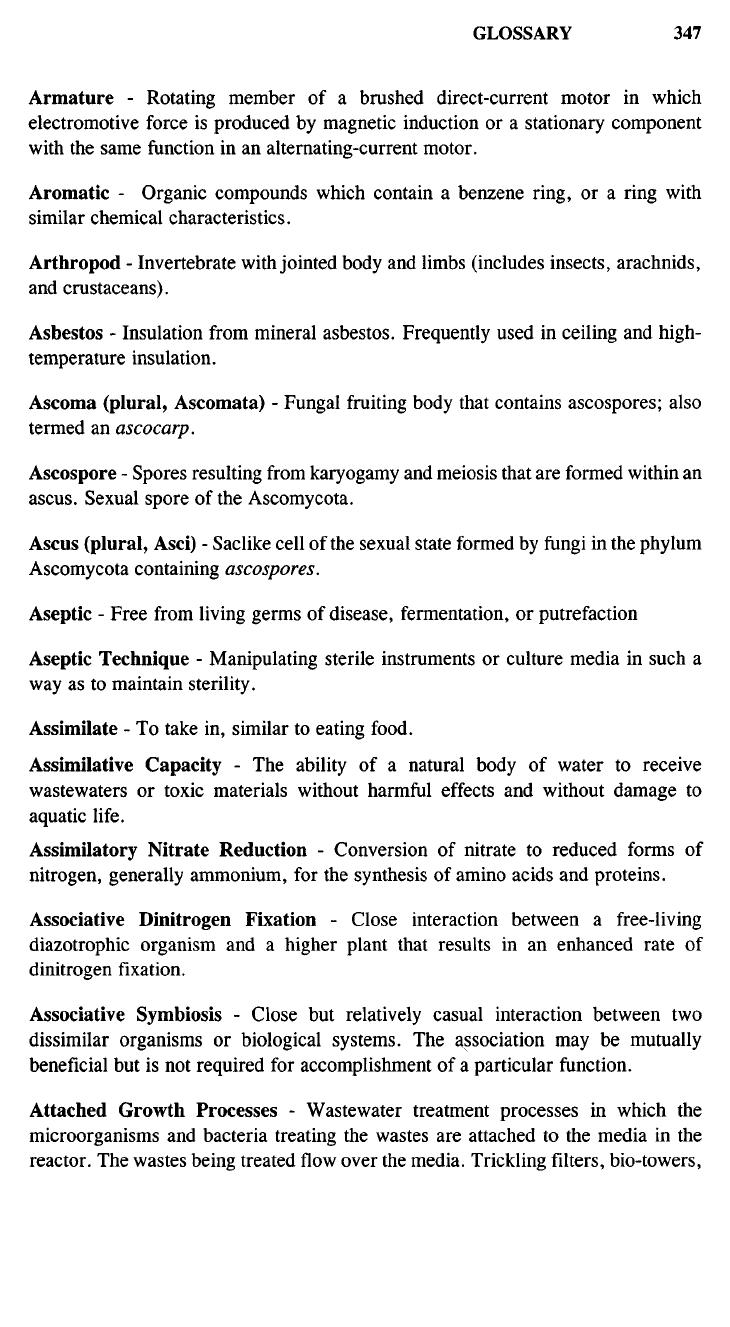
Armature - Rotating member of a brushed direct-current motor in which
electromotive force is produced by magnetic induction or a stationary component
with the same function in an alternating-current motor.
Aromatic - Organic compounds which contain a benzene ring, or a ring with
similar chemical characteristics.
Arthropod - Invertebrate with jointed body and limbs (includes insects, arachnids,
and crustaceans).
Asbestos - Insulation from mineral asbestos. Frequently used in ceiling and high-
temperature insulation.
Ascoma (plural, Ascomata) - Fungal fruiting body that contains ascospores; also
termed an ascocarp.
Ascospore - Spores resulting from karyogamy and meiosis that are formed within an
ascus.
Sexual spore of the Ascomycota.
Ascus (plural, Asci) - Saclike cell of the sexual state formed by fungi in the phylum
Ascomycota containing ascospores.
Aseptic - Free from living germs of disease, fermentation, or putrefaction
Aseptic Technique - Manipulating sterile instruments or culture media in such a
way as to maintain sterility.
Assimilate - To take in, similar to eating food.
Assimilative Capacity - The ability of a natural body of water to receive
wastewaters or toxic materials without harmful effects and without damage to
aquatic life.
Assimilatory Nitrate Reduction - Conversion of nitrate to reduced forms of
nitrogen, generally ammonium, for the synthesis of amino acids and proteins.
Associative Dinitrogen Fixation - Close interaction between a free-living
diazotrophic organism and a higher plant that results in an enhanced rate of
dinitrogen fixation.
Associative Symbiosis - Close but relatively casual interaction between two
dissimilar organisms or biological systems. The association may be mutually
beneficial but is not required for accomplishment of a particular function.
Attached Growth Processes - Wastewater treatment processes in which the
microorganisms and bacteria treating the wastes are attached to the media in the
reactor. The wastes being treated flow over the media. Trickling filters, bio-towers,

and RBCs are attached growth reactors. These reactors can be used for removal of
BOD,
nitrification, and denitrification.
Attenuation - Reduction of the signal power of field strength as a function of
distance through a material. Also refers to shielding effectiveness.
Autoclave - Vessel for heating materials under high steam pressure. Used for
sterilization and other applications.
Autolysis - Spontaneous lysis.
Automatic Oiler - A type of oiler that automatically regulates the oil reservoir level
to keep a bearing properly lubricated.
Automatic Recording Gauge - An automatic instrument for measuring and
recording graphically and continuously.
Automatic Sampling - Collecting of samples of prescribed volume over a defined
time period by an apparatus designed to operate remotely without direct manual
control.
Autoradiography - Detecting radioactivity in a sample, such as a cell or gel, by
placing it in contact with a photographic film.
Autotroph - Organism which uses carbon dioxide as the sole carbon source.
Autotrophic Bacteria - Microorganisms that obtain their carbon and energy for
growth from inorganic compounds. Most autotrophic bacteria are photosynthetic and
use light as a source of energy to assemble the organic molecules they require. Some
autotrophic bacteria carry out chemosynthesis, making organic molecules by using
energy derived from the oxidation of inorganic compounds in the environment.
Autotrophic Nitrification - Oxidation of ammonium to nitrate through the combined
action of two chemoautotrophic organisms, one forming nitrite from ammonium and
the other oxidizing nitrite to nitrate.
Autotrophic Organism - An organism capable of consuming inorganic matter and
converting it to organic matter.
Autotrophy - A unique form of metabolism found only in bacteria. Inorganic
compounds (e.g., NH
3
, NO
2
", S
2
, and Fe
2
+
) are oxidized directly (without using
sunlight) to yield energy. This metabolic mode also requires energy for CO
2
reduction, like photosynthesis, but no lipid-mediated processes are involved. This
metabolic mode has also been called chemotrophy, chemoautotrophy, or
chemolithotrophy.
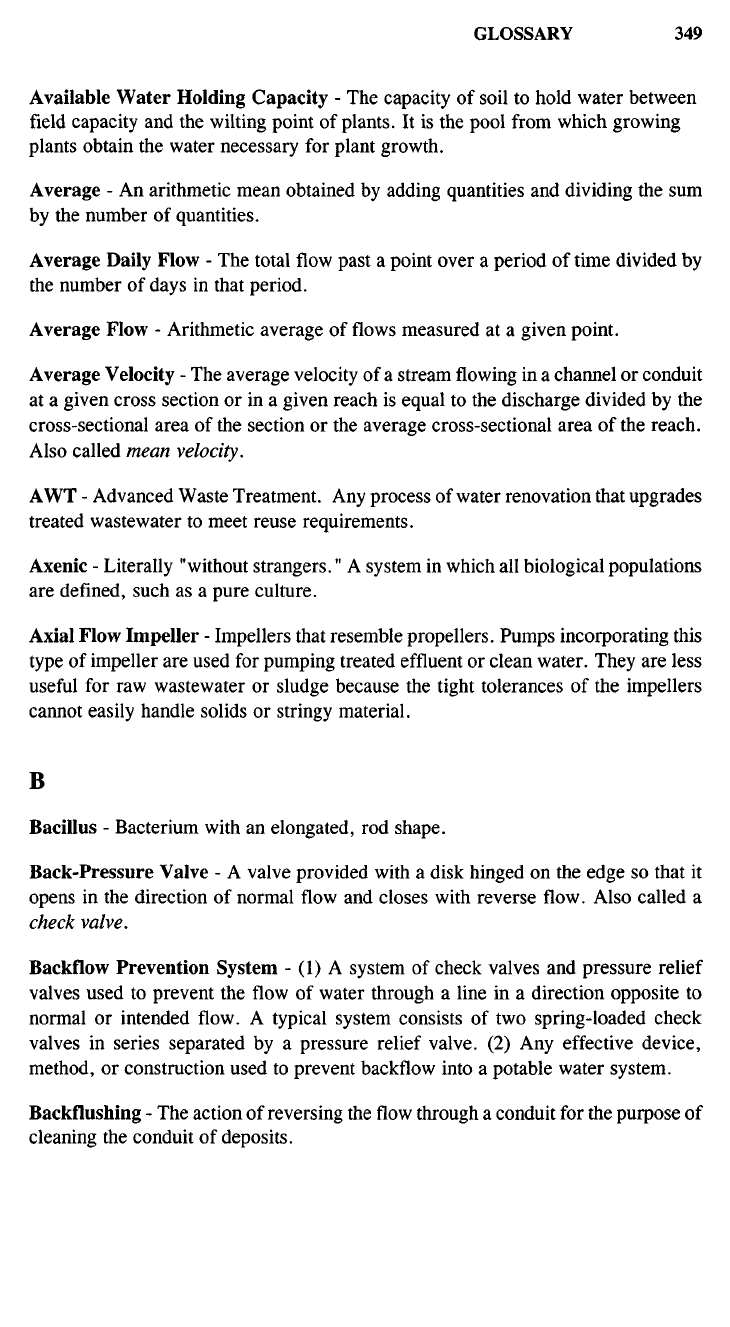
Available Water Holding Capacity - The capacity of soil to hold water between
field capacity and the wilting point of plants. It is the pool from which growing
plants obtain the water necessary for plant growth.
Average - An arithmetic mean obtained by adding quantities and dividing the sum
by the number of quantities.
Average Daily Flow - The total flow past a point over a period of time divided by
the number of days in that period.
Average Flow - Arithmetic average of flows measured at a given point.
Average Velocity - The average velocity of a stream flowing in a channel or conduit
at a given cross section or in a given reach is equal to the discharge divided by the
cross-sectional area of the section or the average cross-sectional area of the reach.
Also called mean velocity.
AWT - Advanced Waste Treatment. Any process of water renovation that upgrades
treated waste water to meet reuse requirements.
Axenic - Literally "without strangers." A system in which all biological populations
are defined, such as a pure culture.
Axial Flow Impeller - Impellers that resemble propellers. Pumps incorporating this
type of impeller are used for pumping treated effluent or clean water. They are less
useful for raw wastewater or sludge because the tight tolerances of the impellers
cannot easily handle solids or stringy material.
B
Bacillus - Bacterium with an elongated, rod shape.
Back-Pressure Valve - A valve provided with a disk hinged on the edge so that it
opens in the direction of normal flow and closes with reverse flow. Also called a
check valve.
Backflow Prevention System - (1) A system of check valves and pressure relief
valves used to prevent the flow of water through a line in a direction opposite to
normal or intended flow. A typical system consists of two spring-loaded check
valves in series separated by a pressure relief valve. (2) Any effective device,
method, or construction used to prevent backflow into a potable water system.
Backflushing - The action of reversing the flow through a conduit for the purpose of
cleaning the conduit of deposits.

Backwashing - The operation of cleaning a filter by reversing the flow of liquid
through it and washing out matter previously captured in it. Filters include true
filters such as sand and diatomaceous earth, but not other treatment units such as
trickling filters.
Bacteria - Living organisms, microscopic in size, which consist of a single cell.
Most bacteria use organic matter for their food and produce waste products as a
result of their life processes.
Bactericide - A pesticide used to control or destroy bacteria, typically in the home,
schools, or on hospital equipment.
Bacterial Analysis - The examination of water and wastewater to determine the
presence, number, and identity of bacteria; more commonly called bacterial
examination. See bacteriological count.
Bacterial Photosynthesis - A light-dependent, anaerobic mode of metabolism.
Carbon dioxide is reduced to glucose, which is used for both biosynthesis and
energy production. Depending on the hydrogen source used to reduce CO
2
, both
photolithotrophic and photoorganotrophic reactions exist in bacteria.
Bacterial Slime - A polysaccharide slime that is produced by many types of
bacteria. This slime helps to hold activated sludge floe together.
Bacteriochlorophyll - Light-absorbing pigment found in green sulfur and purple
sulfur bacteria.
Bacteriocin - Agent produced by certain bacteria that inhibits or kills closely related
isolates and species.
Bacteriological Count - A means for quantifying numbers of organisms. See MPN
index.
Bacteriophage - Virus that infects bacteria, often with destruction or lysis of the
host cell.
Bacteroid - Altered form of cells of certain bacteria. Refers particularly to the
swollen, irregular vacuolated cells of rhizobia in nodules of legumes.
Baffles - Deflector vanes, guides, grids, gratings, or similar devices constructed or
placed in flowing water, wastewater, or slurry systems as a check or to produce a
more uniform distribution of velocities; absorb energy; divert, guide, or agitate the
liquids; and check eddies.
Ball Check Valve - A nonreturn valve in which a ball sits within a cylindrical fluid
line.
Bar Screen - A screen composed of parallel bars, either vertical or inclined, placed
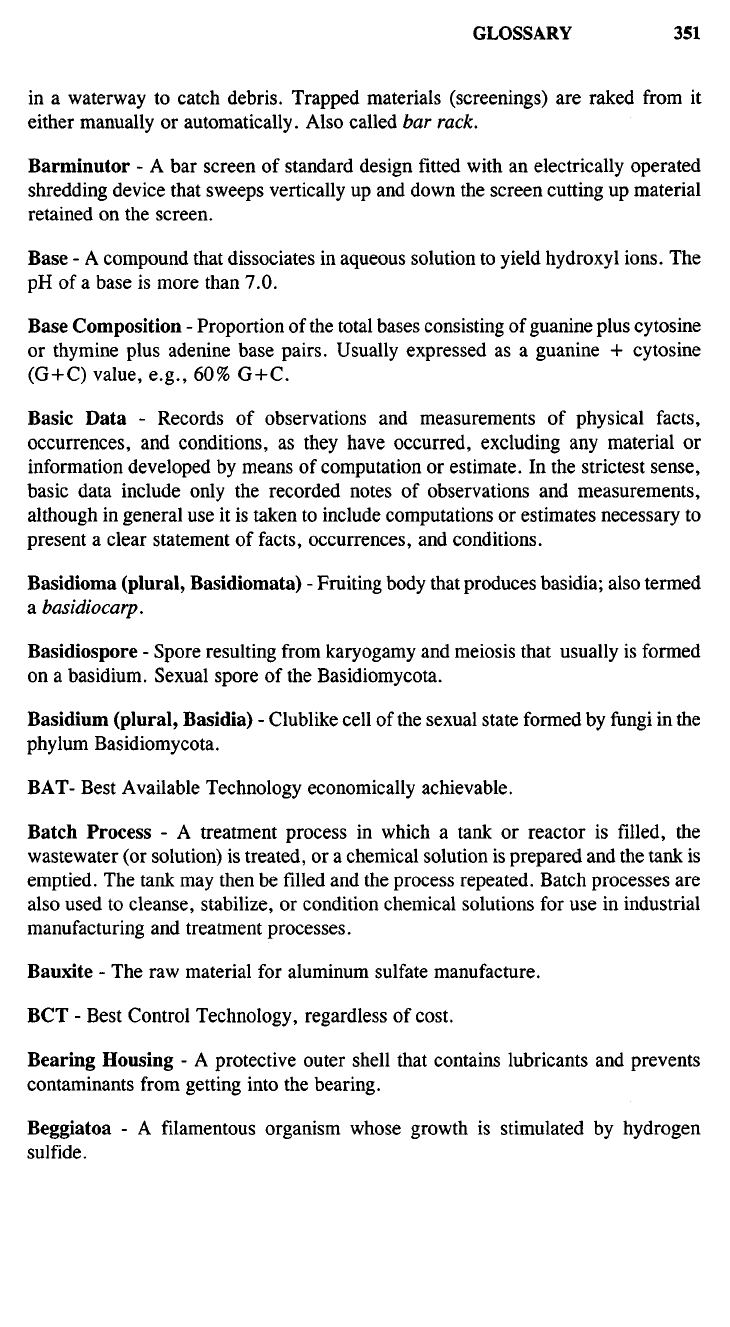
in a waterway to catch debris. Trapped materials (screenings) are raked from it
either manually or automatically. Also called bar rack.
Barminutor - A bar screen of standard design fitted with an electrically operated
shredding device that sweeps vertically up and down the screen cutting up material
retained on the screen.
Base - A compound that dissociates in aqueous solution to yield hydroxyl ions. The
pH of a base is more than 7.0.
Base Composition - Proportion of the total bases consisting of guanine plus cytosine
or thymine plus adenine base pairs. Usually expressed as a guanine + cytosine
(G+C) value, e.g., 60% G+C.
Basic Data - Records of observations and measurements of physical facts,
occurrences, and conditions, as they have occurred, excluding any material or
information developed by means of computation or estimate. In the strictest sense,
basic data include only the recorded notes of observations and measurements,
although in general use it is taken to include computations or estimates necessary to
present a clear statement of facts, occurrences, and conditions.
Basidioma (plural, Basidiomata) - Fruiting body that produces basidia; also termed
a basidiocarp.
Basidiospore - Spore resulting from karyogamy and meiosis that usually is formed
on a basidium. Sexual spore of the Basidiomycota.
Basidium (plural, Basidia) - Clublike cell of the sexual state formed by fungi in the
phylum Basidiomycota.
BAT-
Best Available Technology economically achievable.
Batch Process - A treatment process in which a tank or reactor is filled, the
waste water (or solution) is treated, or a chemical solution is prepared and the tank is
emptied. The tank may then be filled and the process repeated. Batch processes are
also used to cleanse, stabilize, or condition chemical solutions for use in industrial
manufacturing and treatment processes.
Bauxite - The raw material for aluminum sulfate manufacture.
BCT - Best Control Technology, regardless of cost.
Bearing Housing - A protective outer shell that contains lubricants and prevents
contaminants from getting into the bearing.
Beggiatoa - A filamentous organism whose growth is stimulated by hydrogen
sulfide.
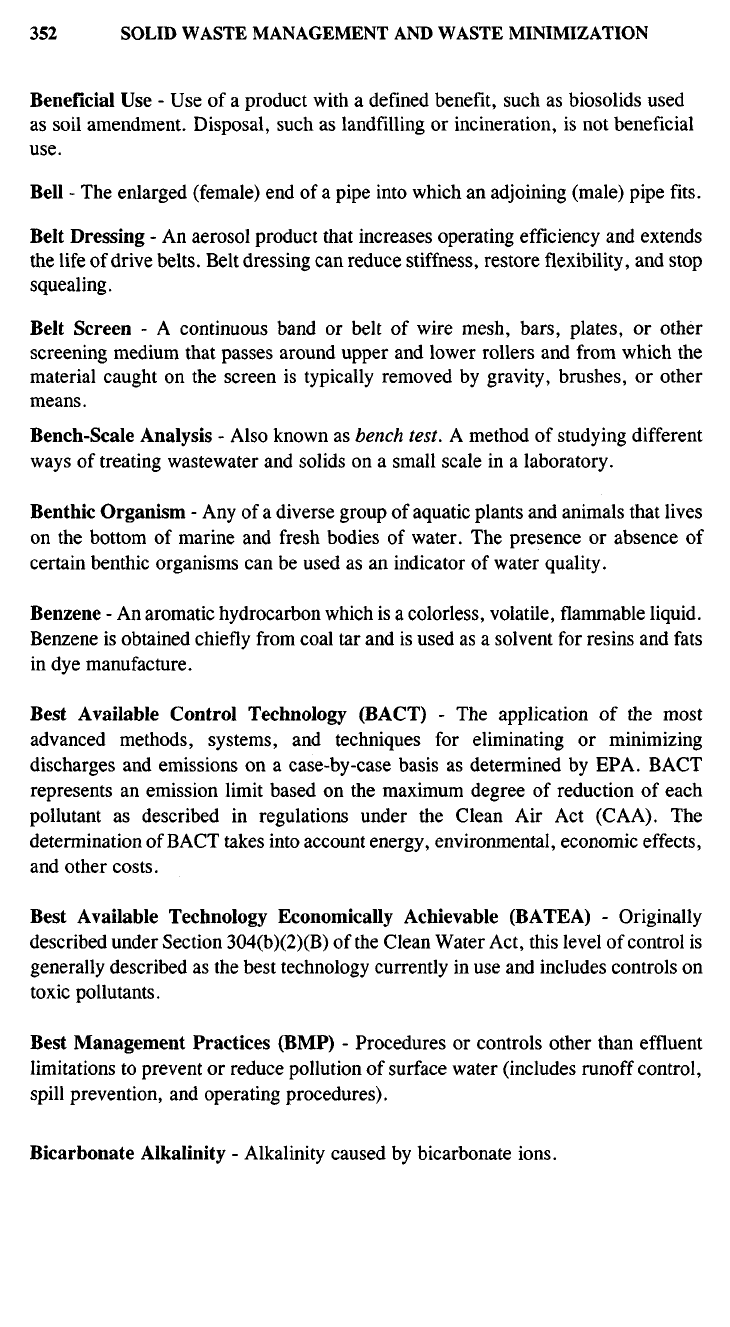
Beneficial Use - Use of a product with a defined benefit, such as biosolids used
as soil amendment. Disposal, such as landfilling or incineration, is not beneficial
use.
Bell - The enlarged (female) end of a pipe into which an adjoining (male) pipe fits.
Belt Dressing - An aerosol product that increases operating efficiency and extends
the life of drive belts. Belt dressing can reduce stiffness, restore flexibility, and stop
squealing.
Belt Screen - A continuous band or belt of wire mesh, bars, plates, or other
screening medium that passes around upper and lower rollers and from which the
material caught on the screen is typically removed by gravity, brushes, or other
means.
Bench-Scale Analysis - Also known as bench test. A method of studying different
ways of treating waste water and solids on a small scale in a laboratory.
Benthic Organism - Any of a diverse group of aquatic plants and animals that lives
on the bottom of marine and fresh bodies of water. The presence or absence of
certain benthic organisms can be used as an indicator of water quality.
Benzene - An aromatic hydrocarbon which is a colorless, volatile, flammable liquid.
Benzene is obtained chiefly from coal tar and is used as a solvent for resins and fats
in dye manufacture.
Best Available Control Technology (BACT) - The application of the most
advanced methods, systems, and techniques for eliminating or minimizing
discharges and emissions on a case-by-case basis as determined by EPA. BACT
represents an emission limit based on the maximum degree of reduction of each
pollutant as described in regulations under the Clean Air Act (CAA). The
determination of BACT takes into account energy, environmental, economic effects,
and other costs.
Best Available Technology Economically Achievable (BATEA) - Originally
described under Section 304(b)(2)(B) of the Clean Water Act, this level of control is
generally described as the best technology currently in use and includes controls on
toxic pollutants.
Best Management Practices (BMP) - Procedures or controls other than effluent
limitations to prevent or reduce pollution of surface water (includes runoff control,
spill prevention, and operating procedures).
Bicarbonate Alkalinity - Alkalinity caused by bicarbonate ions.

Binary Fission - The division of a single-celled organism into two daughter cells.
Binomial Nomenclature - System of having two names, genus and specific epithet,
for each organism.
Bio-Tower - An attached culture system. A tower filled with a media similar to
rachet or plastic rings in which air and water are forced up a counterflow movement
in the tower.
Bioaccumulation - Accumulation of a chemical substance in living tissue.
Bioassay - (1) An assay method using a change in biological activity as a qualitative
or quantitative means of analyzing a material's response to biological treatment. (2)
A method of determining the toxic effects of wastes and wastewaters using viable
organisms under controlled conditions.
Biocatalysis - Chemical reactions mediated by biological systems (microbial
communities, whole organisms or cells, cell-free extracts, or purified enzymes aka
catalytic proteins).
Biochemical - (1) Chemical change resulting from biological action. (2) Pertaining
to the chemistry of plant and animal life.
Biochemicals - Chemicals that are either naturally occurring or identical to naturally
occurring substances. Examples include hormones, pheromones, and enzymes.
Biochemicals function as pesticides through nontoxic, nonlethal modes of action,
such as disrupting the mating pattern of insects, regulating growth, or acting as
repellants. Biochemicals tend to be environmentally compatible and are thus
important to Integrated Pest Management programs.
Biochemical Oxidation - Oxidation brought about by biological activity resulting in
the chemical combination of oxygen with organic matter.
Biochemical Oxygen Demand (BOD) - A measure of the quantity of oxygen used
in the biochemical oxidation of organic matter in a specified time, at a specific
temperature, and under specified conditions.
Biochemical Oxygen Demand Load - The biochemical oxygen demand content,
typically expressed in kilograms or pounds per unit of time, of waste water passing
into a treatment system or water body.
Biocide - A chemical used to control the population of troublesome microbes.
Biodegradable - Substance capable of being decomposed by biological processes.
Biodegradation - The breakdown of organic materials by microorganisms in soils,
bodies of water, and wastewater treatment systems.

Biodiversity - The number and variety of different organisms in the ecological
complexes in which they naturally occur. Organisms are organized at many levels,
ranging from complete ecosystems to the biochemical structures that are the
molecular basis of heredity. Thus, the term encompasses different ecosystems,
species, and genes that must be present for a healthy environment. A large number
of species must characterize the food chain, representing multiple predator-prey
relationships.
Biofilm - A slime layer which naturally develops when bacteria attach to an inert
support that is made of a material such as stone, metal, or wood. There are also
nonfilamentous bacteria that will produce an extracellular polysaccharide that acts as
a natural glue to immobilize the cells. In nature, non-filament-forming
microorganisms will stick to the biofilm surface, locating within an area of the
biofilm that provides an optimal growth environment (i.e., pH, dissolved oxygen,
nutrients). Since nutrients tend to concentrate on solid surfaces, a microorganism
saves energy through cell adhesion to a solid surface rather than by growing
unattached and obtaining nutrients randomly from the medium. Pseudomonas and
Nitrosomonas strains are especially well known for their ability to form a strong
biofilm.
Bioflocculation - The clumping together of fine, dispersed organic particles by the
action of certain bacteria and algae.
Biogeochemistry - Study of microbially mediated chemical transformations of
geochemical interest, such as nitrogen or sulfur cycling.
Biological Denitrification - The transformation of nitrate nitrogen to inert nitrogen
gas by microorganisms in an anoxic environment in the presence of an electron
donor.
Biological Floe - A very fine, fluffy mass formed by the aggregation of fine
suspended particles, as in a precipitate formed by biological activity.
Biological Materials - Biological materials which may be present in waste streams,
including dissolved solids and coliform bacteria (BOD and COD).
Biological Nutrient Removal (BNR) - An adaptation of the conventional activated-
sludge process where anaerobic and anoxic zones are added to biological reactors to
create the correct conditions under which bacteria and other microorganisms are
able to remove nitrogen and phosphorous from waste water.
Biological Oxidation - The process by which living organisms, in the presence of
oxygen, convert organic matter to a more stable or mineral form.
Biological Pesticides - Certain microorganisms, including bacteria, fungi, viruses,
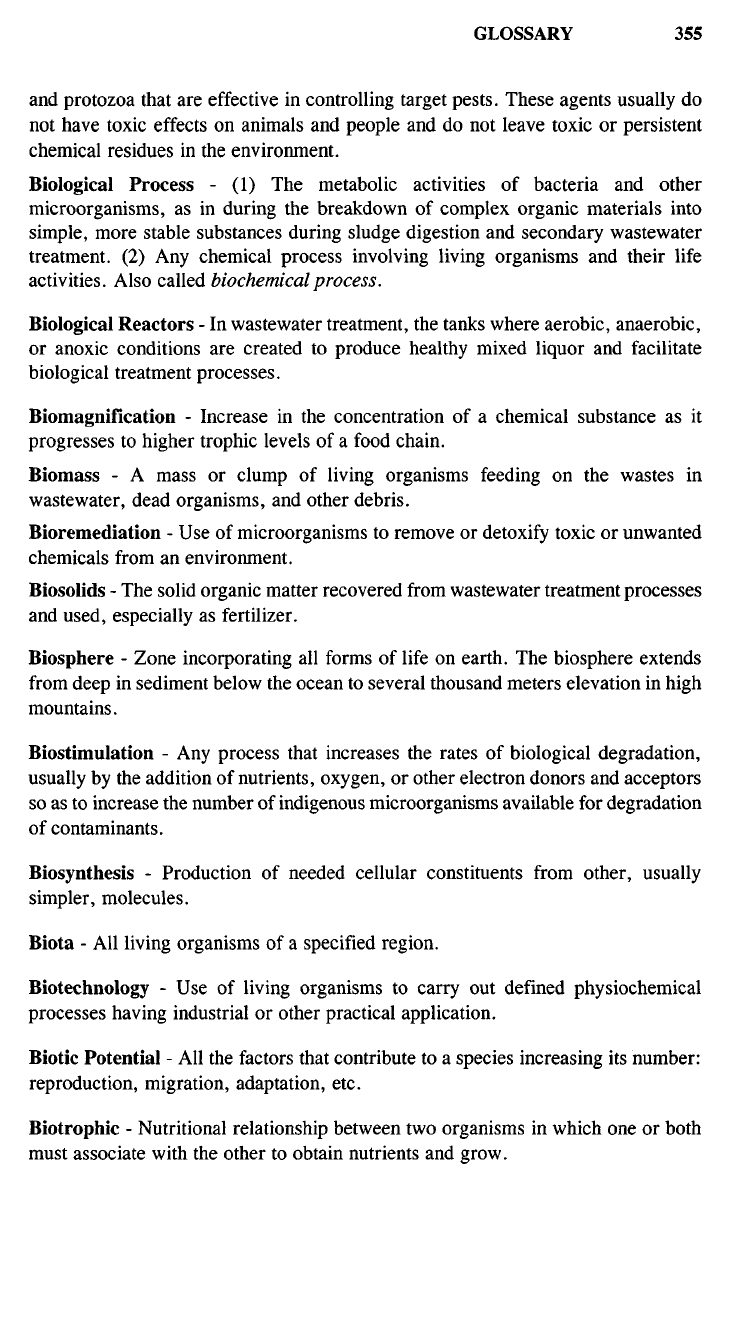
and protozoa that are effective in controlling target pests. These agents usually do
not have toxic effects on animals and people and do not leave toxic or persistent
chemical residues in the environment.
Biological Process - (1) The metabolic activities of bacteria and other
microorganisms, as in during the breakdown of complex organic materials into
simple, more stable substances during sludge digestion and secondary waste water
treatment. (2) Any chemical process involving living organisms and their life
activities. Also called biochemical process.
Biological Reactors - In waste water treatment, the tanks where aerobic, anaerobic,
or anoxic conditions are created to produce healthy mixed liquor and facilitate
biological treatment processes.
Biomagnification - Increase in the concentration of a chemical substance as it
progresses to higher trophic levels of a food chain.
Biomass - A mass or clump of living organisms feeding on the wastes in
wastewater, dead organisms, and other debris.
Bioremediation - Use of microorganisms to remove or detoxify toxic or unwanted
chemicals from an environment.
Biosolids - The solid organic matter recovered from wastewater treatment processes
and used, especially as fertilizer.
Biosphere - Zone incorporating all forms of life on earth. The biosphere extends
from deep in sediment below the ocean to several thousand meters elevation in high
mountains.
Biostimulation - Any process that increases the rates of biological degradation,
usually by the addition of nutrients, oxygen, or other electron donors and acceptors
so as to increase the number of indigenous microorganisms available for degradation
of contaminants.
Biosynthesis - Production of needed cellular constituents from other, usually
simpler, molecules.
Biota - All living organisms of a specified region.
Biotechnology - Use of living organisms to carry out defined physiochemical
processes having industrial or other practical application.
Biotic Potential - All the factors that contribute to a species increasing its number:
reproduction, migration, adaptation, etc.
Biotrophic - Nutritional relationship between two organisms in which one or both
must associate with the other to obtain nutrients and grow.

Bleed - (1) To drain a liquid or gas, as to vent accumulated air from a water line or
to drain a trap or a container of accumulated water. (2) The exuding, percolation, or
seeping of a liquid through a surface.
Blinding - The clogging of the filtering medium of a microscreen or a vacuum filter
when the holes or spaces in the medium become sealed off by a buildup of grease or
the material being filtered. (1) Clogging of the filter cloth of a vacuum filter, belt
press,
belt thickener, or pressure filter. (2) Obstruction of the fine medium of a sand
filter.
Bloom, Algae Bloom - A readily visible concentration of algae growth usually
occurring in the absence of an algaecide when weather, sunlight, and nutrient
conditions favor a logarithmic phase of growth.
Blower - A compressor designed to provide air to a biological reactor or aerobic
digester to provide adequate dissolved oxygen in the fluid to support biological
processes.
BMP - Best Management Practices (BMP) are operating methods that ensure the
proper land application of biosolids for protection of the environment. BMP
include agronomic loading rates, slope limitations, soil pH limitations, buffer
zones,
public access restrictions, grazing deferments, soil conservation practices,
restrictions for saturated and frozen soils, protection of endangered species, and
other site restrictions.
BOD - Biochemical Oxygen Demand. The dissolved oxygen required by organisms
for the aerobic decomposition of organic matter present in water. It is used as a
measure in determining the efficiency of a sewage treatment plant.
BOD Load for Trickling Filter - Pounds of BOD per day, in waste applied, per
1000 cu ft of filter volume.
BOD Percent Reduction - The percent BOD is reduced through treatment. It is a
useful figure in the calculation of waste plant efficiency if not misused.
BOD Test - A procedure that measures the rate of oxygen use under controlled
conditions of time and temperature. Standard test conditions include dark incubation
at 2O
0
C for a specified time (usually 5 days).
Bolting Cloth (Silk) - Screens woven of twisted multifilament natural silk.
Bolting Grade (Wire Cloth) - Weaves that are uniformly woven of stainless steel to
provide high strength and the largest possible pore openings.
Boom - (1) A floating device used to contain oil on a body of water. (2) A piece of
equipment used to apply pesticides from a tractor or truck.
